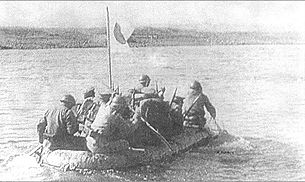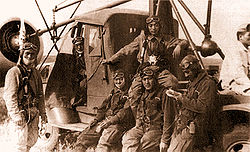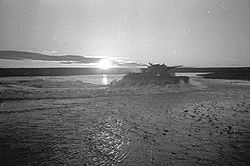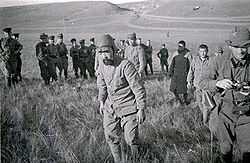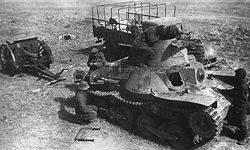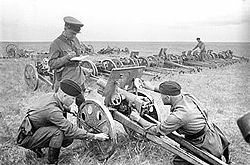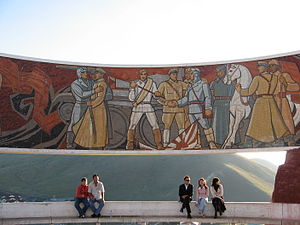- Battles of Khalkhin Gol
-
Battle of Khalkhyn Gol (Battle of Nomonhan) Part of the Soviet-Japanese Border Wars 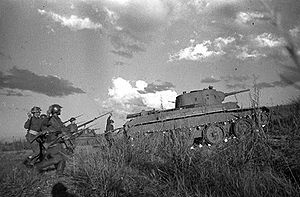
Khalkhyn Gol, August 1939. Offensive of Soviet BT-7 tanksDate 11 May – 16 September 1939 Location Khalkha River, Mongolian People's Republic Result Decisive Soviet and Mongolian victory Belligerents  Soviet Union
Soviet Union
 Mongolian People's Republic
Mongolian People's Republic Empire of Japan
Empire of Japan
 Manchukuo
ManchukuoCommanders and leaders  Georgy Zhukov
Georgy Zhukov
 Khorloogiin Choibalsan
Khorloogiin Choibalsan
 Grigoriy Shtern
Grigoriy Shtern
 Yakov Smushkevich
Yakov Smushkevich Michitarō Komatsubara
Michitarō Komatsubara
 Yasuoka Masaomi
Yasuoka MasaomiStrength 57,000,
500 tanks,
250 aircraft[1]38,000 (initially),
135 tanks,
250 aircraft[1]Casualties and losses Archival research:
 : 7,974 killed,
: 7,974 killed,
15,251 wounded[2]
 : 274.[3]
: 274.[3]Japanese claim:
8,440 killed,
8,766 wounded
Soviet claim:
60,000 killed and wounded,
3,000 captured[4]Soviet–Japanese border conflictsHalhamiao – Orahodoga – Tauran – Kanchazu island – Lake Khasan – Khalkhin GolCampaigns of World War IIEurope
Other Campaigns
Poland – Phoney War – Denmark & Norway
France & Benelux – Britain – Balkans – Yugoslav Front – Eastern Front –Finland - Western Front (1944–45)
Asia & The Pacific
China – Pacific Ocean – South-East Asia
South West Pacific – Japan – Manchuria (1945)
Mediterranean, Middle East and Africa
Atlantic – Strategic Bombing - America
Contemporaneous Wars
Chinese Civil – Winter War – Soviet–Japanese Border – French–Thai – Ili RebellionCoordinates: 47°43′49″N 118°35′24″E / 47.73028°N 118.59°E The Battles of Khalkhyn Gol (Mongolian: Халхын голын байлдаан; Russian: бой на реке Халхин-Гол; Chinese: 诺蒙坎事件 Nuò méng kǎn shìjiàn) was the decisive engagement of the undeclared Soviet–Japanese Border Wars fought among the Soviet Union, Mongolia and the Empire of Japan in 1939. The conflict was named after the river Khalkhyn Gol, which passes through the battlefield. In Japan, the decisive battle of the conflict is known as the Nomonhan Incident (ノモンハン事件 Nomonhan jiken) after a nearby village on the border between Mongolia and Manchuria. The battles resulted in total defeat for the Japanese Sixth Army.
Contents
Background
After the occupation of Manchuria, Japan turned its military interests to Soviet territories that bordered those areas. The first major Soviet-Japanese border incident, the Battle of Lake Khasan, happened in 1938 in Primorye. Clashes between Japanese and Soviet forces frequently occurred on the border of Manchuria.
In 1939, Manchuria was a puppet state of Japan, known as Manchukuo. The Japanese maintained that the border between Manchukuo and the Mongolian People's Republic was the Khalkhyn Gol (English "Khalkha River") which flows into Lake Buir. In contrast, the Mongolians and their Soviet allies maintained that the border ran some 16 kilometres (9.9 mi) east of the river, just east of Nomonhan village.[5]
The principal occupying army of Manchukuo was the Kwantung Army of Japan, consisting of some of the best Japanese units in 1939. However, the western region of Manchukuo was garrisoned by the newly formed IJA 23rd Infantry Division (23rd ID) at Hailar, under General Michitarō Komatsubara and included several Manchukuoan army and border guard units.
Soviet forces consisted of the 57th Special Corps, forward deployed from the Trans-Baikal Military District, responsible for defending the border between Siberia and Manchuria. The Mongolian troops mainly consisted of cavalry brigades and light artillery units, and proved to be effective and agile, but lacked armour and man power in sufficient numbers.
In 1939, the Japanese Cabinet sent instructions to the Kwantung Army to strengthen and fortify Manchukuo's borders with Mongolia and the Soviet Union. Additionally, the Kwantung Army, which had long been stationed in Manchuria far from the Japanese home islands, had become largely autonomous and did not need to seek approval from the Japanese government before acting aggressively against the Soviets.[6]
May, June, and July actions
The incident began on 11 May 1939. A Mongolian cavalry unit of some 70–90 men had entered the disputed area in search of grazing for their horses. On that day, Manchukuoan cavalry attacked the Mongolians and drove them back across the Khalkhin Gol. On 13 May, the Mongolian force returned in greater numbers and the Manchukoans were unable to dislodge them.
On 14 May, Lt. Col. Yaozo Azuma led the reconnaissance regiment of 23rd ID, supported by the 64th Infantry Regiment of the same division, under Colonel Takemitsu Yamagata, into the territory and the Mongolians withdrew. However, Soviet and Mongolian troops returned to the disputed region and Azuma's force again moved to evict them. This time things turned out differently, as the Soviet-Mongolian forces surrounded Azuma's force on 28 May and destroyed it.[7] The Azuma force suffered eight officers and 97 men killed and one officer and 33 men wounded, for 63% total casualties. The commander of the Soviet forces and the Far East Front was Comandarm Grigori Shtern from May 1938.[1]
Both sides began building up their forces in the area: soon Japan had 30,000 men in the theater. The Soviets dispatched a new Corps commander, Comcor Georgy Zhukov, who arrived on 5 June and brought more motorized and armored forces (I Army Group) to the combat zone.[8] Together with Zhukov arrived Comcor Yakov Smushkevich with his aviation unit. On 27 June, the Japanese launched an air attack. The IJAF 2nd Air Brigade (2nd AB) struck the Soviet air base at Tamsak-Bulak in Mongolia. The Japanese won this engagement, but the strike had been ordered by the Kwangtung Army without getting permission from Imperial Japanese Army headquarters in Tokyo. In an effort to prevent the incident from escalating,[9] Tokyo promptly ordered the Japanese Army Air Force to not conduct any more air strikes against Soviet airbases.[10]
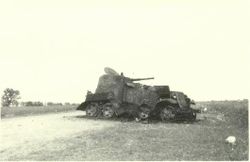 Destroyed Soviet armored car BA-10
Destroyed Soviet armored car BA-10
Throughout June, there were continuing reports of Soviet and Mongolian activity on both sides of the river near Nomonhan, and small-scale attacks on isolated Manchukoan units. At the end of the month, the commander of the Japanese 23rd ID, Lt. Gen. Michitarō Komatsubara, was given permission to "expel the invaders". The Japanese plan was for a two-pronged assault. Three regiments plus part of a fourth, including three from the 23rd ID—the 71st and the 72nd Infantry Regiments, plus a battalion of the 64th Infantry Regiment—and the 26th Infantry Regiment under Colonel Shinichiro Sumi, "borrowed" from the 7th ID, would advance across the Khalkin Gol, destroy Soviet forces on Baintsagan Hill on the west bank, then make a left turn and advance south to the Kawatama Bridge. The second prong of the attack would be the task of the IJA 1st Tank Corps (1st TC)[11] (Yasuoka Detachment), consisting of the 3rd and the 4th Tank Regiments, plus a part of the 64th Inf. Regiment, a battalion from the 28th Infantry Regiment, detached from the 7th ID, 24th Engineer Regiment, and a battalion from the 13th Field Artillery Regiment, under overall command of Lieutenant General Yasuoka Masaomi. This force would attack Soviet troops on the east bank of the Khalkhyn Gol and north of the Holsten River. The two Japanese thrusts would meet on the wings.
IJA Lt. Gen. Yasuoka Masaomi, Cdr, 1st Tank Corps[11]
- 3rd Tank Regiment[12]
- Type 89 I-Go medium tanks - 26
- Type 97 Chi-Ha medium tanks - 4
- Type 94 tankettes - 7
- Type 97 Te-Ke tankettes - 4
- 4th Tank Regiment[13]
- Type 95 Ha-Go light tanks - 35
- Type 89 I-Go medium tanks - 8
- Type 94 tankettes - 3
The northern task force succeeded in crossing the Khalkhyn Gol, driving the Soviets from Baintsagan Hill, and advancing south along the west bank. However, Zhukov, perceiving the threat, launched a counterattack with 450 tanks and armored cars. The Soviet armored force, despite being unsupported by infantry, attacked the Japanese on three sides and nearly encircled them. The Japanese force, further handicapped by having only one pontoon bridge across the river for supplies, was forced to withdraw, recrossing the river on 5 July. Meanwhile, the 1st Tank Corps of the Yasuoka Detachment (the southern task force) attacked on the night of 2 July, moving in the darkness to avoid the Soviet artillery on the high ground of the river's west bank. A pitched battle ensued in which the Yasuoka Detachment lost over half its armor, but still could not break through the Soviet forces on the east bank and reach the Kawatama Bridge.[14][15] After a Soviet counterattack on 9 July threw the battered, depleted Yasuoka Detachment back, it was dissolved and Yasuoka was relieved.[16]
The two armies continued to spar with each other over the next two weeks along a four km (2.5 miles) front running along the east bank of the Khalkhyn Gol to its junction with the Holsten River.[17] Zhukov, whose army was 748 km (465 mi) away from its base of supply, assembled a fleet of 2600 trucks to supply his troops, while the Japanese suffered severe supply problems due to a lack of similar motor transport.[10] On 23 July, the Japanese launched another large-scale assault, sending the 64th and 72nd Infantry Regiments against Soviet forces defending the Kawatama Bridge. Japanese artillery supported the attack with a massive barrage that consumed more than half of their ammunition stores over a period of two days.[18] The attack made some progress but failed to break through Soviet lines and reach the bridge. The Japanese disengaged from the attack on 25 July due to mounting casualties and depleted artillery stores. They had suffered over five thousand casualties to this point but still had 75,000 men and some hundred planes facing the Soviet forces.[10] The battle drifted into stalemate.
August: Zhukov's strike
The Japanese regrouped, and planned a third major offensive against the Soviets for 24 August.[10] However, with war apparently imminent in Europe, Zhukov planned a major offensive on 20 August, to clear the Japanese from the Khalkhin Gol region and end the fighting.[19] Zhukov assembled a powerful armored force of three tank brigades (the 4th, 6th and 11th), and two mechanized brigades (the 7th and 8th, which were armored car units with attached infantry support). This force was allocated to the Soviet left and right wings. The entire Soviet force consisted of three rifle divisions, two tank divisions and two more tank brigades (in all, some 498 BT-5 and BT-7 tanks[20]), two motorized infantry divisions, and over 550 fighters and bombers.[21] The Mongolians committed two cavalry divisions.[22][23][24]
By contrast, at the point of attack the Kwantung Army had only Lieutenant General Michitarō Komatsubara's 23rd Infantry Division, which with attached forces was equivalent to two light infantry divisions. Its headquarters had been at Hailar, over 150 km from the site of the fighting. Japanese intelligence had also failed to detect the scale of the Soviet buildup or the scope of the imminent offensive.[25]
Zhukov decided it was time to break the stalemate.[21] On 20 August 1939, at 0545 hours (5:45AM) Soviet artillery and 557 fighters and bombers[21] attacked Japanese positions, the first fighter/bomber offensive in Soviet Air Force history.[26] Approximately 50,000 Soviet and Mongolian troops of the 57th Special Corps defended the east bank of the Khalkhyn Gol. Three infantry divisions and a tank brigade crossed the river, supported by massed artillery and the best planes of the Soviet Air Force. Once the Japanese were pinned down by the attack of Soviet center units, Soviet armored units swept around the flanks and attacked the Japanese in the rear, achieving a classic double envelopment. When the Soviet wings linked up at Nomonhan village on 25 August, the Japanese 23rd ID was trapped.[10][27][28] On 26 August, a Japanese counterattack to relieve the 23rd ID failed. On 27 August, the 23rd ID attempted to break out of the encirclement, but also failed. When the surrounded forces refused to surrender, they were again hit with artillery and air attacks. By 31 August, the Japanese forces on the Soviet side of the border were destroyed, leaving remnants of the 23rd ID on the Manchurian side. The Soviet forces had achieved their objective.[29]
The Japanese commander, Komatsubara, refused to accept the outcome of the battle, and prepared a counteroffensive. This was canceled when a cease-fire was signed in Moscow. While Zhukov defeated the Japanese forces from Soviet territory, Stalin had made a deal with Nazi Germany.[21] After the Soviet success at Nomonhan, Stalin decided to proceed with the Molotov-Ribbentrop Pact, which was announced on 24 August. Though World War II broke out in Europe on 1 September, the Soviet Union had declared its neutrality there. This meant the Soviet Union could concentrate all its forces in the east if needed, and the Japanese position was clearly hopeless.
Stalin had no further ambitions in the east, so the Soviet Union and Japan agreed to a cease-fire on 15 September; it took effect the following day.[10] With no threat of war in the Far East, Stalin proceeded with the Soviet invasion of Poland (1939) on 17 September.[30]
Aftermath
Japanese tank Type 95 Ha-Go captured by Soviet troops after battle of Khalkhin Gol
Casualty estimates vary widely: Some sources say the Japanese suffered 45,000 or more soldiers killed with Soviet casualties of at least 17,000,.[10] The Japanese officially reported 8,440 killed and 8,766 wounded, while the Soviets initially claimed 9,284 total casualties. It is likely that figures published at the time were reduced for propaganda purposes. In recent years, with the opening of the Soviet archives, a more accurate assessment of Soviet casualties has emerged from the work of Grigoriy Krivosheev, citing 7,974 killed and 15,251 wounded.[2] Similar research into Japanese casualties has yet to take place.
Although this engagement is little-known in the West, it played a important part in the subsequent Japanese conduct of World War II, because it contributed to determine that the two principal Axis Powers, Germany and Japan, would never geographically link up their areas of control through the Soviet Union. The defeat, together with other factors, lost the support of the Imperial General Staff in Tokyo for the policy of the North Strike Group, favoured by the Army, which wanted to seize Siberia as far as Lake Baikal for its resources. Among others, these factors include the signing of the Nazi-Soviet non-aggression pact, that deprived the Army of the basis of its war policy against the USSR, and gained the fury of the Emperor with the Army, not so much due to its defeat, but because it initiated such an undeclared war without authorization. Now the South Strike Group, favored by the navy, which wanted to seize the resources of Southeast Asia, especially the petroleum and mineral-rich Dutch East Indies, started to gain ascendancy. Because the European colonial powers were weak and being defeated in the war with Germany, coupled with their embargoes on Japan (especially of vital oil) in the second half of 1941, the result was the attack on Pearl Harbor, on December 7th of that year. Despite plans being carried out for war against the USSR, the Japanese would never make an offensive movement again. In 1941, the two countries signed agreements respecting the borders of Mongolia and Manchukuo[31] and pledging neutrality towards each other.[32] They remained at peace until the Soviet Union declared war on Japan in August 1945, and attacked IJA forces stationed in Manchuria, during the final weeks of the war.
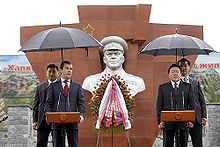 Russian President Dmitry Medvedev and Mongolian President Tsakhiagiin Elbegdorj at a ceremony in Ulaanbaatar in August 2009, commemorating the 70th anniversary of the Battle.
Russian President Dmitry Medvedev and Mongolian President Tsakhiagiin Elbegdorj at a ceremony in Ulaanbaatar in August 2009, commemorating the 70th anniversary of the Battle.
It was the first victory for the soon-to-be-famous Soviet general Georgy Zhukov, earning him the first of his four Hero of the Soviet Union awards. The other generals Grigoriy Shtern and Yakov Smushkevich, whose roles were no less important and who also earned the Hero title, were forgotten. Zhukov himself was promoted and transferred west to the Kiev district. The battle experience gained by Zhukov was put to good use in December 1941 at the Battle of Moscow. Zhukov was able to use this experience to launch the first successful Soviet counteroffensive against the German invasion of 1941. Many units of the Siberian and other trans-Ural armies were part of this attack, and the decision to move the divisions from Siberia was aided by the Soviet masterspy Richard Sorge in Tokyo, who was able to alert the Soviet government that the Japanese were looking south and were unlikely to launch another attack against Siberia in the immediate future. A year after flinging the Germans back from Moscow, Zhukov planned and executed the Red Army's offensive at the Battle of Stalingrad, using a technique very similar to Khalkhin Gol, in which the Soviet forces held the enemy fixed in the center, built up a mass of force in the area undetected, and launched a pincer attack on the wings to trap the enemy army.
The Zaisan Memorial, a communist-era mosaic symbolising the "joint Soviet-Mongolian victory" over Japan.
The Japanese, however, made no major strategic changes. They continued to underestimate their adversaries, deploying piecemeal units instead of mass units, emphasizing the courage and determination of the individual soldier to make up for the lack of firepower, protection, or overwhelming numbers. The problems that faced them at Khalkhin Gol, most importantly their deployment of only two light infantry divisions, and two tank regiments, would plague them again when the Americans and British recovered from their defeats of late 1941 and early 1942 and turned to the conquest of the Japanese Empire.[10][33]
At the International Military Tribunal for the Far East, fourteen Japanese were charged with having "initiated a war of aggression . . . against the Mongolian People's Republic in the area of the Khalkhin-Gol River" and also with having waged a war "in violation of international law" against the USSR.[34] Kenji Doihara, Hiranuma Kiichirō, and Seishirō Itagaki were convicted on these charges.
The Mongolian town of Choibalsan, in the Dornod aimag (province) where the battle was fought, is the location of the "G.K. Zhukov Museum", dedicated to Zhukov and the 1939 battle.[35] Ulaanbaatar, Mongolia also has a "G.K. Zhukov Museum" with information about the battle of Khalkhin Gol.[36]
Notes
- ^ a b c Grigoriy Shtern
- ^ a b "Grif sekretnosti sniat': poteri Vooruzhennykh Sil SSSR v voynakh, boevykh deystviyakh i voennykh konfliktakh", pod oshchey redaktsiey G. F. Krivosheeva. (Moskva: Voennoe izd-vo, 1993, ISBN 5203014000). pp. 77–85.
- ^ Baabar (1999), p. 389
- ^ Glantz, David M.; and House, Jonathan. When Titans Clashed: How the Red Army Stopped Hitler. Lawrence, KS: UP of Kansas, 1995. ISBN 0700608990 p. 14.
- ^ Drea, Edward J. "Leavenworth Papers No. 2 Nomonhan: Japanese Soviet Tactical Combat, 1939 – MAPS" – Retrieved: 13 May 2007.
- ^ Baabar (1999), p. 384-6.
- ^ Drea, Edward J. "Leavenworth Papers No. 2 Nomonhan: Japanese Soviet Tactical Combat, 1939 – BIG MAPS – Map 3" – Retrieved: 13 May 2007.
- ^ Baabar (1999), p. 386-7.
- ^ Coox, p. 271
- ^ a b c d e f g h Timothy Neeno, M.A. Nomonhan: The Second Russo-Japanese War, 2005. – Retrieved: 12 May 2007.
- ^ a b Coox, p. 1119
- ^ Coox, p. 349
- ^ Coox, p. 350
- ^ Combined Arms Research Library
- ^ Drea, Edward J. "Leavenworth Papers No. 2 Nomonhan: Japanese Soviet Tactical Combat, 1939 – BIG MAPS – Map 4" – Retrieved: 13 May 2007.
- ^ Combined Arms Research Library: Redeployment
- ^ Combined Arms Research Library: Japanese Initiatives
- ^ Combined Arms Research Library: Hills 742 and 754
- ^ Coox, pp. 578-579
- ^ Coox, p. 579, p. 641, notation 23
- ^ a b c d Coox, p. 590
- ^ Combined Arms Research Library: The Soviet Offensive
- ^ Drea, Edward J. "Leavenworth Papers No. 2 Nomonhan: Japanese Soviet Tactical Combat, 1939 – BIG MAPS – Map 6" – Retrieved: 13 May 2007.
- ^ Leavenworth Papers No. 2 Nomonhan: Japanese-Soviet Tactical Combat, 1939; MAPS
- ^ Combined Arms Research Library:Japanese Intelligence Failures
- ^ Coox, p. 663
- ^ Combined Arms Research Library: Outcome
- ^ Combined Arms Research Library: Encirclement of the 2/28th Infantry
- ^ Coox, p. 841
- ^ Steven J. Zaloga, Howard Gerrard, Poland 1939: the birth of Blitzkrieg, Osprey Publishing, 2002, ISBN 1841764086, p. 80
- ^ "Declaration Regarding Mongolia", 14 April 1941. – Retrieved: 13 May 2007.
- ^ "Pact of Neutrality between Union of Soviet Socialist Republics and Japan," 13 April 1941. – Retrieved: 13 May 2007
- ^ Combined Arms Research Library
- ^ See counts 26 and 36 of the IMTFE indictment, available at http://www.trumanlibrary.org/whistlestop/study_collections/nuremberg/documents/index.php?documentdate=0000-00-00&documentid=18-2&pagenumber=1
- ^ Cultological Culture
- ^ List of museums
References
- Baabar, B. (1999). From world power to Soviet satellite: History of Mongolia. University of Cambridge Press. OCLC 318985384
- Chiyoko Sasaki: Der Nomonhan Konflikt: Das fernöstl. Vorspiel zum 2. Weltkrieg. Bonn University, 1968. Phil. F., Diss. 6. Nov. 1968.
- Coox, Alvin D.: Nomonhan: Japan Against Russia, 1939. Two volumes; 1985, Stanford University Press. ISBN 0-8047-1160-7
- Drea, Edward: Nomonhan: Japanese-Soviet Tactical Combat, 1939. Leavenworth Papers study for the Combat Studies Institute of the U.S. Army.
- Drea, Edward J. (1998). "Tradition and Circumstances: The Imperial Japanese Army's Tactical Response to Khalkhin-Gol, 1939". In the Service of the Emperor: Essays on the Imperial Japanese Army. Nebraska: University of Nebraska Press. ISBN 0-8032-1708-0.
- Erickson, John: The Soviet High Command: A Military-Political History, 1918–1941. Routledge, 2001. ISBN 0-7146-5178-8.
- Onda Shigetaka: Ningen no kiroku: Nomonhan-sen (人間の記録 ノモンハン戦). Tokio: Gandaishi shuppan kai, Tokuma shoten, 1977.
- Neeno, Timothy: Nomonhan: The Second Russo-Japanese War. MilitaryHistoryOnline.com essay. Uses the Coox book and Drea paper as sources.
- Zaloga, Steven J. Japanese Tanks 1939–45. (2007) Osprey. ISBN 978-1-84603-091-8.
External links
- "LIFE" magazine article on combat at Khalkhin Gol, Aug. 7, 1939
- Topographic Map of the Khalkhin Gol battle area
- Videos of the Nomonhan War Museum
- Warbird Forum – Japan vs. Russia, 1939
- "On the Road to Khalkhin Gol", Part 1 and Part 2, by Henry Sakaida
Categories:- Battles involving Japan
- Battles involving the Soviet Union
- Battles involving Mongolia
- Conflicts in 1939
- Manchukuo
- Wars involving Mongolia
- History of Manchuria
- 1939 in Japan
- 1939 in Mongolia
- 1939 in the Soviet Union
- Japan–Soviet Union relations
- Mongolia–Russia relations
- 3rd Tank Regiment[12]
Wikimedia Foundation. 2010.

